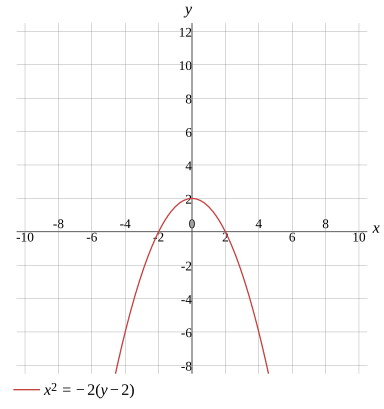Question
Function
Find the x-intercept/zero
Find the y-intercept
x1=−2,x2=2
Evaluate
x2+2y=4
To find the x-intercept,set y=0
x2+2×0=4
Any expression multiplied by 0 equals 0
x2+0=4
Removing 0 doesn't change the value,so remove it from the expression
x2=4
Take the root of both sides of the equation and remember to use both positive and negative roots
x=±4
Simplify the expression
More Steps


Evaluate
4
Write the number in exponential form with the base of 2
22
Reduce the index of the radical and exponent with 2
2
x=±2
Separate the equation into 2 possible cases
x=2x=−2
Solution
x1=−2,x2=2
Show Solution

Solve the equation
Solve for x
Solve for y
x=4−2yx=−4−2y
Evaluate
x2+2y=4
Move the expression to the right-hand side and change its sign
x2=4−2y
Take the root of both sides of the equation and remember to use both positive and negative roots
x=±4−2y
Solution
x=4−2yx=−4−2y
Show Solution

Testing for symmetry
Testing for symmetry about the origin
Testing for symmetry about the x-axis
Testing for symmetry about the y-axis
Not symmetry with respect to the origin
Evaluate
x2+2y=4
To test if the graph of x2+2y=4 is symmetry with respect to the origin,substitute -x for x and -y for y
(−x)2+2(−y)=4
Evaluate
More Steps


Evaluate
(−x)2+2(−y)
Multiply the numbers
(−x)2−2y
Rewrite the expression
x2−2y
x2−2y=4
Solution
Not symmetry with respect to the origin
Show Solution

Identify the conic
Find the standard equation of the parabola
Find the vertex of the parabola
Find the focus of the parabola
Load more

x2=−2(y−2)
Evaluate
x2+2y=4
Move the expression to the right-hand side and change its sign
x2=4−2y
Use the commutative property to reorder the terms
x2=−2y+4
Solution
x2=−2(y−2)
Show Solution

Rewrite the equation
r=cos2(θ)−sin(θ)+1+3cos2(θ)r=−cos2(θ)sin(θ)+1+3cos2(θ)
Evaluate
x2+2y=4
To convert the equation to polar coordinates,substitute x for rcos(θ) and y for rsin(θ)
(cos(θ)×r)2+2sin(θ)×r=4
Factor the expression
cos2(θ)×r2+2sin(θ)×r=4
Subtract the terms
cos2(θ)×r2+2sin(θ)×r−4=4−4
Evaluate
cos2(θ)×r2+2sin(θ)×r−4=0
Solve using the quadratic formula
r=2cos2(θ)−2sin(θ)±(2sin(θ))2−4cos2(θ)(−4)
Simplify
r=2cos2(θ)−2sin(θ)±4+12cos2(θ)
Separate the equation into 2 possible cases
r=2cos2(θ)−2sin(θ)+4+12cos2(θ)r=2cos2(θ)−2sin(θ)−4+12cos2(θ)
Evaluate
More Steps


Evaluate
2cos2(θ)−2sin(θ)+4+12cos2(θ)
Simplify the root
More Steps


Evaluate
4+12cos2(θ)
Factor the expression
4(1+3cos2(θ))
Write the number in exponential form with the base of 2
22(1+3cos2(θ))
Calculate
21+3cos2(θ)
2cos2(θ)−2sin(θ)+21+3cos2(θ)
Factor
2cos2(θ)2(−sin(θ)+1+3cos2(θ))
Reduce the fraction
cos2(θ)−sin(θ)+1+3cos2(θ)
r=cos2(θ)−sin(θ)+1+3cos2(θ)r=2cos2(θ)−2sin(θ)−4+12cos2(θ)
Solution
More Steps


Evaluate
2cos2(θ)−2sin(θ)−4+12cos2(θ)
Simplify the root
More Steps


Evaluate
4+12cos2(θ)
Factor the expression
4(1+3cos2(θ))
Write the number in exponential form with the base of 2
22(1+3cos2(θ))
Calculate
21+3cos2(θ)
2cos2(θ)−2sin(θ)−21+3cos2(θ)
Use b−a=−ba=−ba to rewrite the fraction
−2cos2(θ)2sin(θ)+21+3cos2(θ)
Factor
−2cos2(θ)2(sin(θ)+1+3cos2(θ))
Reduce the fraction
−cos2(θ)sin(θ)+1+3cos2(θ)
r=cos2(θ)−sin(θ)+1+3cos2(θ)r=−cos2(θ)sin(θ)+1+3cos2(θ)
Show Solution

Find the first derivative
Find the derivative with respect to x
Find the derivative with respect to y
dxdy=−x
Calculate
x2+2y=4
Take the derivative of both sides
dxd(x2+2y)=dxd(4)
Calculate the derivative
More Steps


Evaluate
dxd(x2+2y)
Use differentiation rules
dxd(x2)+dxd(2y)
Use dxdxn=nxn−1 to find derivative
2x+dxd(2y)
Evaluate the derivative
More Steps


Evaluate
dxd(2y)
Use differentiation rules
dyd(2y)×dxdy
Evaluate the derivative
2dxdy
2x+2dxdy
2x+2dxdy=dxd(4)
Calculate the derivative
2x+2dxdy=0
Move the expression to the right-hand side and change its sign
2dxdy=0−2x
Removing 0 doesn't change the value,so remove it from the expression
2dxdy=−2x
Divide both sides
22dxdy=2−2x
Divide the numbers
dxdy=2−2x
Solution
More Steps


Evaluate
2−2x
Reduce the numbers
1−x
Calculate
−x
dxdy=−x
Show Solution

Find the second derivative
Find the second derivative with respect to x
Find the second derivative with respect to y
dx2d2y=−1
Calculate
x2+2y=4
Take the derivative of both sides
dxd(x2+2y)=dxd(4)
Calculate the derivative
More Steps


Evaluate
dxd(x2+2y)
Use differentiation rules
dxd(x2)+dxd(2y)
Use dxdxn=nxn−1 to find derivative
2x+dxd(2y)
Evaluate the derivative
More Steps


Evaluate
dxd(2y)
Use differentiation rules
dyd(2y)×dxdy
Evaluate the derivative
2dxdy
2x+2dxdy
2x+2dxdy=dxd(4)
Calculate the derivative
2x+2dxdy=0
Move the expression to the right-hand side and change its sign
2dxdy=0−2x
Removing 0 doesn't change the value,so remove it from the expression
2dxdy=−2x
Divide both sides
22dxdy=2−2x
Divide the numbers
dxdy=2−2x
Divide the numbers
More Steps


Evaluate
2−2x
Reduce the numbers
1−x
Calculate
−x
dxdy=−x
Take the derivative of both sides
dxd(dxdy)=dxd(−x)
Calculate the derivative
dx2d2y=dxd(−x)
Use differentiation rule dxd(cf(x))=c×dxd(f(x))
dx2d2y=−dxd(x)
Solution
dx2d2y=−1
Show Solution

Graph
